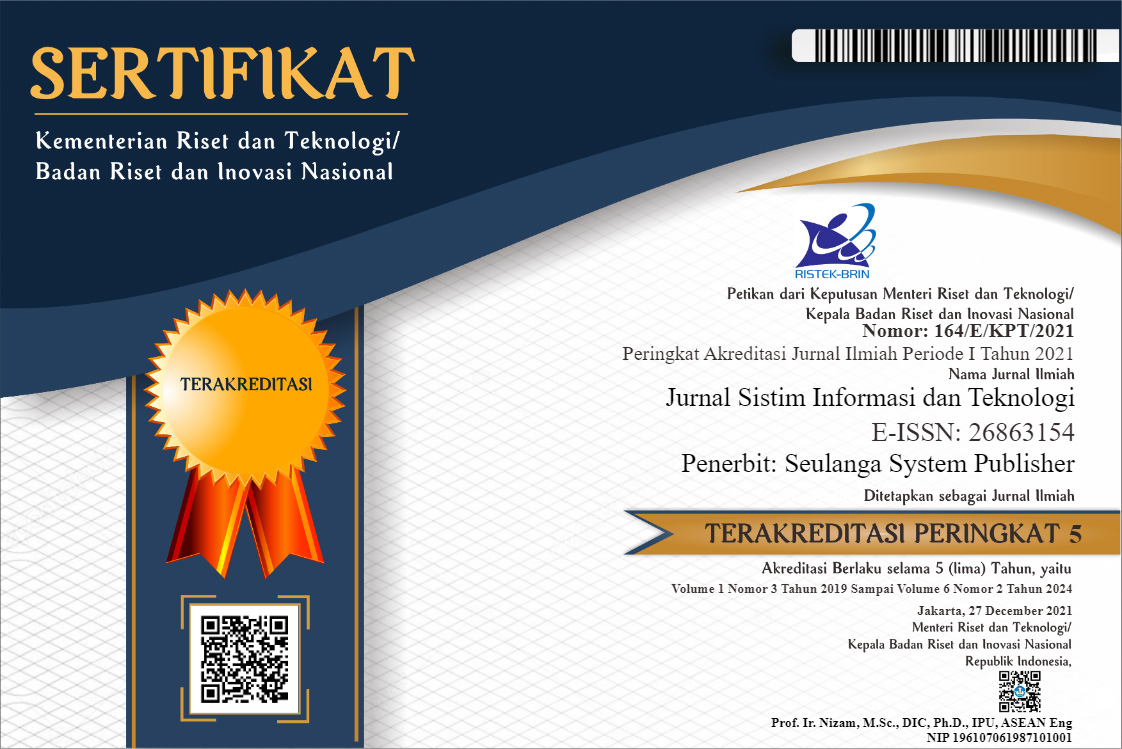Algoritma K-Means Clustering dalam Mengklasifikasi Data Daerah Rawan Tindak Kriminalitas (Polres Kepulauan Mentawai)
DOI:
https://doi.org/10.37034/jsisfotek.v3i4.73Keywords:
Clustering, Data Mining, Crime, Motor Vehicle Theft, K-MeansAbstract
Crime is all kinds of actions and actions that are economically and psychologically harmful that violate the laws in force in the State of Indonesia as well as social and religious norms. Ordinary criminal acts affect the security of the community and threaten their inner and outer peace. The research location is the Mentawai Islands Police, which is an agency that can provide security and protection for the community, especially those in the Mentawai Islands Regency. The problem is that it is difficult for the Mentawai Islands Police to classify areas that are prone to crime in the most vulnerable, moderately vulnerable and not vulnerable categories. Especially considering the condition of the Mentawai, there are four large islands consisting of 10 sub-districts, where crime is increasing every year, especially those in the Mentawai Islands Regency area such as motor vehicle theft. Based on the background of the problem above, the researcher is interested in taking research in creating a system to predict the crime rate in the Mentawai Islands Regency in order to anticipate the surge in crime that will come. The method used is the K-Means Clustering Algorithm as a non-hierarchical data clustering method to partition existing data into one or more clusters or groups. This method partitions data into clusters so that data with the same characteristics are grouped into the same cluster and data with different characteristics are grouped into other clusters. Clustering is one of the data mining techniques used to get groups of objects that have common characteristics in large enough data. The data used is data on cases of criminal theft of motor vehicles for the last 5 years from 2016 to 2020. The results of the test show that South Sipora District is an area prone to the crime of motor vehicle theft.
References
Atmaja, E. H. S. (2019). Implementation of k-Medoids Clustering Algorithm to Cluster Crime Patterns in Yogyakarta. International Journal of Applied Sciences and Smart Technologies, 1(1), 33–44. https://doi.org/10.24071/ijasst.v1i1.1859
Haris Kurniawan, Sarjon Defit, & Sumijan. (2020). Data Mining Menggunakan Metode K-Means Clustering Untuk Menentukan Besaran Uang Kuliah Tunggal. Journal of Applied Computer Science and Technology, 1(2), 80–89. https://doi.org/10.52158/jacost.v1i2.102
Suryadi, U. T., & Supriatna, Y. (2019). Sistem Clustering Tindak Kejahatan Pencurian Di Wilayah Jawa Barat Menggunakan Algoritma K-Means. Jurnal Teknologi Dan Komunikasi STMIK Subang, 12(1), 15–27. https://doi.org/10.47561/a.v12i1.147
Alibuhtto, M. C., & Mahat, N. I. (2020). Distance based k-means clustering algorithm for determining number of clusters for high dimensional data. Decision Science Letters, 9(1), 51–58. https://doi.org/10.5267/j.dsl.2019.8.002
Kumar, S., Kumar-Solanki, V., Choudhary, S. K., Selamat, A., & Gonzalez-Crespo, R. (2020). Comparative Study on Ant Colony Optimization (ACO) and K-Means Clustering Approaches for Jobs Scheduling and Energy Optimization Model in Internet of Things (IoT). International Journal of Interactive Multimedia and Artificial Intelligence, 6(1), 107. https://doi.org/10.9781/ijimai.2020.01.003
Singh, A., Mehta, J. C., Anand, D., Nath, P., Pandey, B., & Khamparia, A. (2021). An intelligent hybrid approach for hepatitis disease diagnosis: Combining enhanced k-means clustering and improved ensemble learning. Expert Systems, 38(1). https://doi.org/10.1111/exsy.12526
Kim, H. S., Kim, S. K., & Kang, L. S. (2021). BIM performance assessment system using a K-means clustering algorithm. Journal of Asian Architecture and Building Engineering, 20(1), 78–87. https://doi.org/10.1080/13467581.2020.1800471
Febriyati, N. A., Gs, A. D., & Wanto, A. (2020). "GRDP Growth Rate Clustering in Surabaya City uses the K- Means Algorithm". International Journal of Information System & Technology, 3(2), 276–283.
Westari, D. (2021). Performa Comparison of the K-Means Method for Classification in Diabetes Patients Using Two Normalization Methods. International Journal of Multidisciplinary Research and Analysis, 04(01), 18–23. https://doi.org/10.47191/ijmra/v4-i1-03
Andri Nofiar Am, Sarjon Defit, S. (2019). "Penentuan Mutu Kelapa Sawit Menggunakan Metode K-Means Clustering". KomTekInfo, 5(3), 1–9.
Ardiada, D., Ariawan, P. A., & Sudarma, M. (2018). "Evaluation of Supporting Work Quality Using K-Means Algorithm". IJEET International Journal of Engineering and Emerging Technology, 3(1), 3–6.
Fatmawati, K., & Windarto, A. P. (2018). Data Mining: Penerapan Rapidminer Dengan K-Means Cluster Pada Daerah Terjangkit Demam Berdarah Dengue (Dbd) Berdasarkan Provinsi. Computer Engineering, Science and System Journal, 3(2), 173. https://doi.org/10.24114/cess.v3i2.9661
Gustientiedina, G., Adiya, M. H., & Desnelita, Y. (2019). Penerapan Algoritma K-Means Untuk Clustering Data Obat-Obatan. Jurnal Nasional Teknologi Dan Sistem Informasi, 5(1), 17–24. https://doi.org/10.25077/tek`nosi.v5i1.2019.17-24
Mahmudan, A. (2020). Clustering of District or City in Central Java Based COVID-19 Case Using K-Means Clustering. Jurnal Matematika, Statistika Dan Komputasi, 17(1), 1–13. https://doi.org/10.20956/jmsk.v17i1.10727
Purba, W., Tamba, S., & Saragih, J. (2018). The effect of mining data k-means clustering toward students profile model drop out potential. Journal of Physics: Conference Series, 1007(1). https://doi.org/10.1088/1742-6596/1007/1/012049
Putra, R. R., & Wadisman, C. (2018). Implementasi Data Mining Pemilihan Pelanggan Potensial Menggunakan Algoritma K Means. INTECOMS: Journal of Information Technology and Computer Science, 1(1), 72–77. https://doi.org/10.31539/intecoms.v1i1.141
Suriani, L. (2020). Pengelompokan Data Kriminal Pada Poldasu Menentukan Pola Daerah Rawan Tindak Kriminal Menggunakan Data Mining Algoritma K-Means Clustering. Jurnal Sistem Komputer Dan Informatika (JSON), 1(2), 151. https://doi.org/10.30865/json.v1i2.1955









